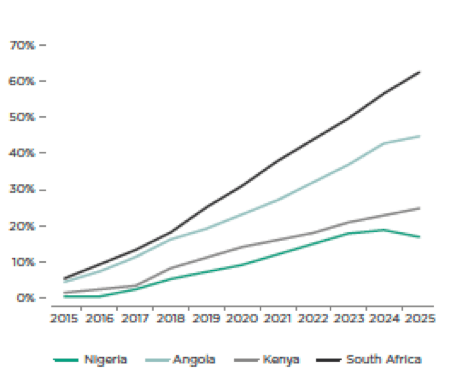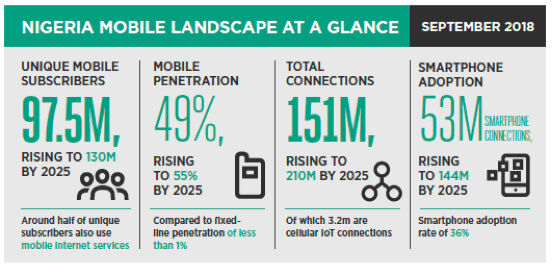Increasing numbers of mobile subscribers is positive but it’s not the same as meeting extended coverage goals. Recent reports focus on the need to deliver speed, but this doesn’t change the fundamental problem. Mobility remains concentrated.
Recent GSMA reports(1) have noted how, in absolute terms, some countries are enjoying a surge in mobile customers. However, despite growth, one such report notes the relatively low penetration of 4G mobile broadband, particularly in comparison with others. While connectivity has grown, the speeds available have not. It appears that many MNOs are sitting on their 4G spectrum and choose not to deploy it.
4G adoption in Nigeria (GSMA Intelligence, 2018)

The availability of more cost-effective solutions for deploying 4G coverage, such as WTL’s Vivada can help here. It provides an easy means to extend coverage footprints and to close gaps in national 4G plans.
It’s admirable to highlight the need to build out more 4G coverage, but it still rather misses the point. Indeed, the report notes that mobile penetration stands at 49% of the population, which is forecast to grow to 55% by 2025. First, this means that nearly 50% of the country is beyond the range of coverage.
Nigerian mobile market evolution (GSMA Intelligence)

Second – and perhaps worse – it means that the rate of growth is slow. Indeed, this growth could simply be accounted for by expansion of urban populations.
In other words, coverage is still not reaching those outside the range of conventional networks. Just because more people are being connected – albeit slowly – it does not mean that coverage is being extended to rural populations. Instead, coverage appears to be concentrated where it is already.
That’s a serious problem and it’s disappointing that the GSMA does not draw more attention to this fact and simply points to the need for more speed. Speed helps, but it’s not the answer. The answer is to build out coverage in areas that are not reached today. Connectivity at any speed delivers benefits – pace TIP, it’s not about enabling access to media or to entertainment. While nice to have, these do not deliver economic and development benefits on their own.
To deliver benefits from increased collaboration, education, IoT services, remote monitoring, power, and more, it’s perfectly reasonable to start with 2G and then, once demand has been proven upgrade to higher rates. The GSMA is right to suggest that enhanced data rates are necessary, but they are not sufficient to meet economic and developmental goals. What’s needed, then, are solutions, such as Vivada from WTL, that can be deployed remotely and are self-contained, allowing not only new coverage to be delivered to the most remote regions, but also allowing 2G and 4G to be deployed as required, or a simple upgrade path from one to the other on the same core infrastructure.
Real efforts to extend the coverage footprint are essential – otherwise, the growth will only be seen in existing metro areas. Sometimes, numbers conceal a wider truth. Adding new mobile connections is one part of the picture; extending geographical footprint quite another matter entirely.
[1] E.g. “Spotlight on Nigeria” GSMA, 2018


